Manchester Carriage Company,
later the Manchester Carriage and Tramways Company
History
The Manchester Carriage Company commenced horse-drawn tramway operation on the newly built, standard-gauge line between Pendleton and Higher Broughton (Kersal Bar) — via Albert Bridge and Deansgate, in Manchester — on the 17th May 1877. The lines were owned by Manchester and Salford Corporations, and were branded as 'Manchester and Salford Tramways'. Operation of the line was actually leased to Messrs Busby and Turton, two well-known figures in the tramway world who, without the knowledge of the corporations, had transferred the lease to the MCCo. The corporations took an extremely dim view of this, so much so that they refused to formally recognise the MCCo as the lessee, even though it ran all the services! Messrs Busby and Turton had never had any intention of operating the tramway themselves, and this move unfortunately set the tone for future relations, particularly with Salford Corporation, as all their planned lines, unlike those of Manchester Corporation, had also been included in the original lease. The dispute over the lease even continued after the 2nd August 1880, when the MCCo was merged with the Manchester Suburban Tramways Company (this was a vehicle used by Busby, Turton and the MCCo to secure tramway powers) to form the Manchester Carriage and Tramways Company. The dispute was eventually resolved on the 25th June 1890, a staggering 13 years after matters first came to a head.
The horse tramway system expanded dramatically during the early 1880s, and by 1886, the MC&TCo operated around 80 miles of tramway: 25 miles owned by the company; 28 miles by Manchester Corporation; 13 miles by Salford Corporation; 5 miles by Oldham Corporation; and 7 miles by Barton, Eccles, Winton, Monton, Moss Side, Newton Heath and Withington Local Boards. Although further lines were built in the 1890s, these tended to be small extensions or diversionary lines, rather than major routes.
From Manchester city centre, lines eventually ran: northwards to Cheetham Hill and Barnes Green; northeastwards to Oldham and Waterhead; eastwards to Clayton, Openshaw, Ashton-under-Lyne and Stalybridge; southeastwards to Denton and Stockport; southwards to West Didsbury, Moss Side and Whalley Range; southwestwards to Stretford; eastwards to Eccles and Peel Green, and northwestwards to Swinton, Pendlebury, Lower Broughton and Broughton Park. Although the MC&TCo met the tracks of the Manchester, Bury and Oldham Steam Tramways Company (at Broughton and Oldham), as well as those of the horse-drawn Stockport and Hazel Grove Carriage and Tramway Company (at Stockport) no through running ever took place.
By 1896, both Salford and Manchester Corporations had decided to convert their respective tracks to electric traction, and with this in mind, the MC&TCo's Salford leases were extended such that they all expired on the same day as Manchester's (the 27th April 1901). Although the company attempted to obtain powers to convert the system to electric traction, there was concerted opposition from the many local authorities through which its lines ran, and it was clear to all that the MC&TCo's days were numbered. In early 1898, in a rare and short-lived atmosphere of municipal planning and cooperation, the local authorities came together to discuss and agree which of them would operate new electric tramway services (Ashton-under-Lyne, Manchester, Oldham, Salford, Stalybridge, and Stockport) and which would rely upon them for a service (Audenshaw, Denton, Droylsden, Eccles, Failsworth, Gorton, Heaton Norris, Levenshulme, Moss Side, Stretford, Swinton and Pendlebury, and Withington).
Manchester and Salford Corporations took control of their respective lines on the 1st May 1901; Salford elected to operate the horse services itself, whereas Manchester reached agreement for the MC&TCo to continue operation during conversion to overhead electric traction. Manchester also agreed to provide services over former MC&TCo lines purchased by Stockport Corporation, which it subsequently electrified and operated under a lease arrangement. Oldham Corporation on the other hand, chose to press ahead immediately with conversion, so horse services stopped abruptly on the 31st October 1901. Ashton and Stalybridge Corporations took possession on the 1st April 1903, with Manchester Corporation agreeing to provide horse services pending conversion to electric overhead traction.
The last MC&TCo horse tram ran on the 31st March 1903, and the last horse tram of all over former MC&TCo metals (operated by Manchester Corporation) on the 14th October 1903.
The MC&TCo was a well-run and profitable concern, distributing the quite staggering sum of £1,167,965 to its shareholders when finally wound up.
Uniforms
Photographs depicting staff of the Manchester Carriage Company (1870-1880) — operators of Manchester and Salford Tramways - are relatively rare, but those that do exist indicate that employees wore informal attire, comprising jackets, shirts and ties, and bowler hats. Fortunately, there is a much larger body of photographic evidence covering its later incarnation (the Manchester Carriage and Tramways Company), so I am able state with some confidence what tramcar staff wore from 1880 onwards, though precise dating always remains a challenge.
The 'MC&TCo' clearly enforced a strict policy with respect to staff attire, and though formal uniforms were not issued, staff were expected to wear smart jackets (with white handkerchiefs), white shirts and bowler hats (all devoid of insignia). In later years, when straw boaters became fashionable, conductors and drivers often wore these in summertime, clearly with the blessing of the company. A few photographs do however exist, which show staff wearing flat caps, and generally looking somewhat less smart; it is possible, but far from certain, that company rules in respect of attire were relaxed in the period leading up to the municipal takeover, and that these photographs stem from the last months/years of operation.
Coachmen's coats, greatcoats and blankets were also worn, presumably during the colder months, but once again, there appears to have been no standard issue. The use of informal attire was in fact fairly common practice amongst horse tramway operators, many of them never seeing fit to issue uniforms or insignia of any kind. Drivers and conductors did however wear a large oval brass licence, which was suspended on a leather hanger, invariably from the cash-bag strap (in the case of conductors); the precise pattern is unclear, though it may well have born the wording 'Manchester' and the grade (presumably 'Driver' or 'Conductor'), along with a number (see below).
Although the Manchester Carriage and Tramways Company definitely employed inspectors, photographs appear not to have survived, so it is currently unclear what uniforms, if any, they wore.
I am indebted to Ted Gray for high resolution copies of photos from his collection, many of which were first published in book form to celebrate the centenary of the company (see below). I would also like to acknowledge Jayne Shrimpton for her expertise in dating photos based upon clothing and headwear styles.
Further reading
For a detailed history of the MC&TCO, see: 'The Manchester Carriage and Tramways Company' by Ted Gray; Manchester Transport Museum Society (1977).
Images
Horse tram drivers and conductors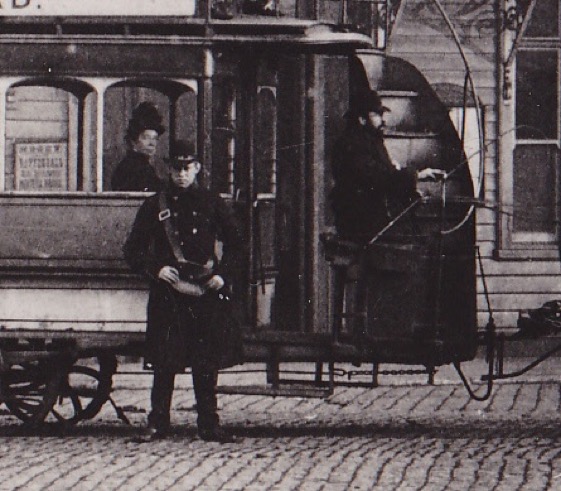
Driver and conductor with Horsecar P-4 (a Starbuck-built car based at Pendleton Depot), pictured outside Eccles Station — photo undated, but probably taken in either 1889 and 1890. The tall bowers with upturned brims are characteristic of the late 1880s. With thanks to Ted Gray. 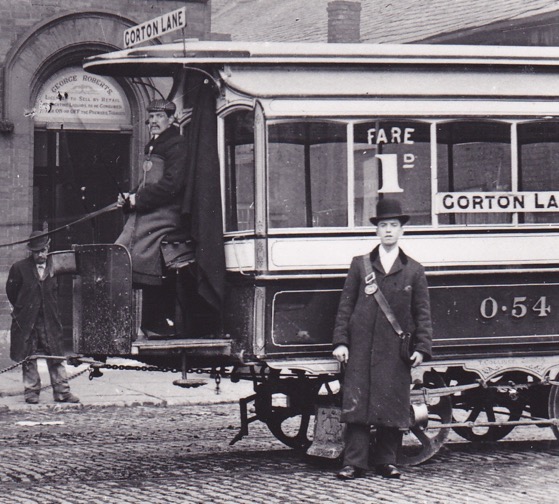
Driver and conductor pose with Horsecar O-54 (an Oldham and Openshaw car) on Ashton Old Road with a working to Gorton Lane — photo dated 1888 to 1889. It was evidently winter as the conductor is wearing a long overcoat, whilst the driver is wrapped up to his chest in a woollen blanket. The conductor's oval licence is clearly visible on the his cash-bag strap. With thanks to Ted Gray. 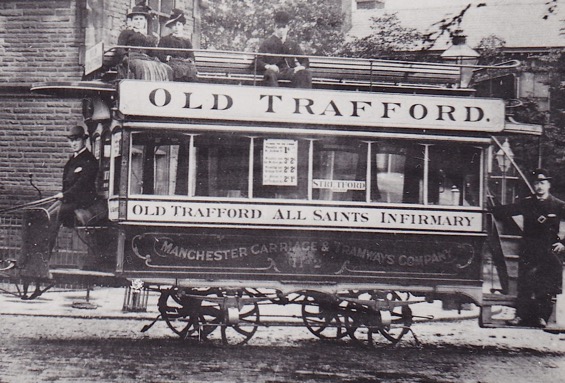
Driver and conductor with Horsecar H-2 (a Hulme Depot car) at Trafford Bar on a short working to Old Trafford — photo undated, but from the style of clothing, very probably taken in the late 1880s or early 1890s. Although no uniform or badges are in evidence, both men are very smartly dressed, suggesting that this was a company rule/requirement. With thanks to Ted Gray. 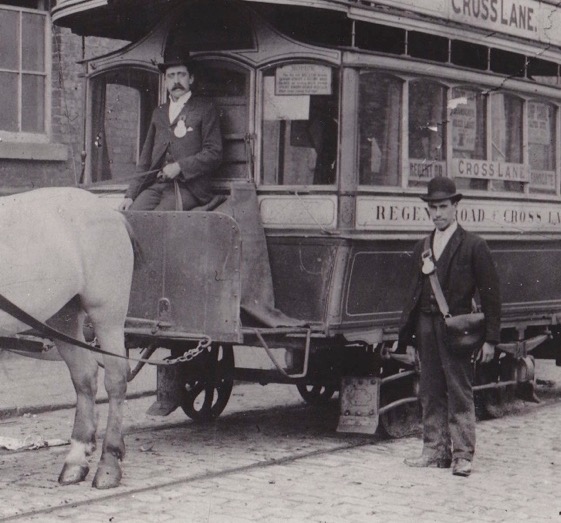
A Weaste-based horsecar in Heyworth Street at the side entrance to Weaste Depot, about to depart on a service to Cross Lane — photo undated, but from the bowler hats, probably taken between the mid-1880s and mid-1890s. Both men's licences are easily seen. With thanks to Ted Gray. 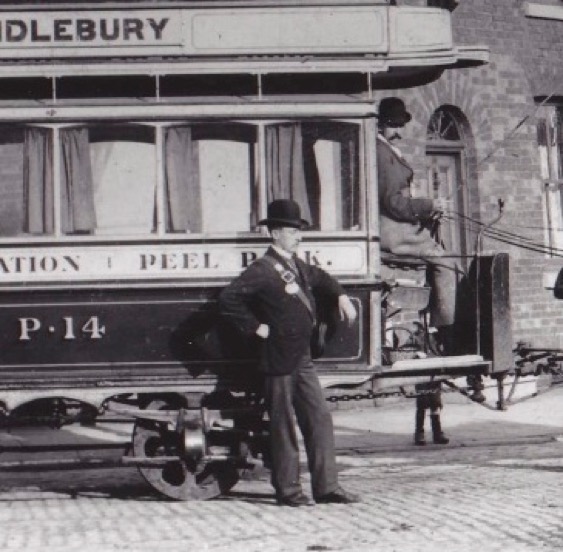
Conductor and driver pose with Horsecar P-14 (a Pendleton Depot car) with a service from Pendlebury, just poised to turn into Chorley Rd, Swinton — photo taken in 1898 when the Pendlebury route was opened. The photographer was a Mr E Yates, whose chemist shop is behind the tramcar. An oval licence is once again clearly visible on the conductor's cash-bag strap. With thanks to Ted Gray. 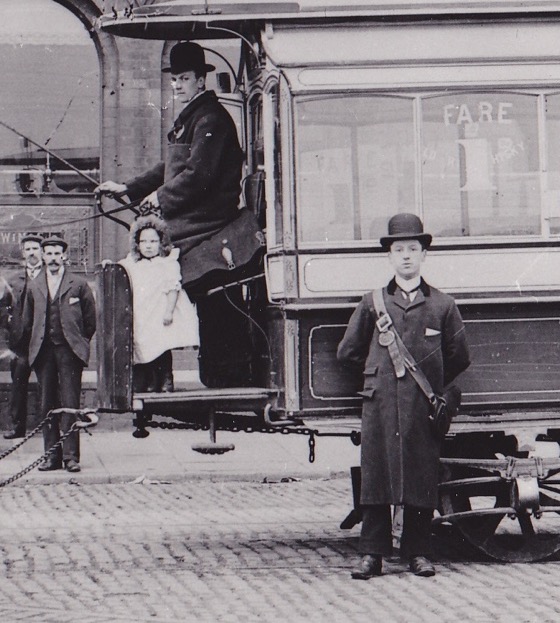
Another shot of Horsecar O-54 in Ashton Old Rd on a service to Gorton Lane, with a rather sullen looking platform passenger — photo undated. The conductor's coat is identical to that in the previous photo, raising the possibility that may have bought them from the same supplier. With thanks to Ted Gray.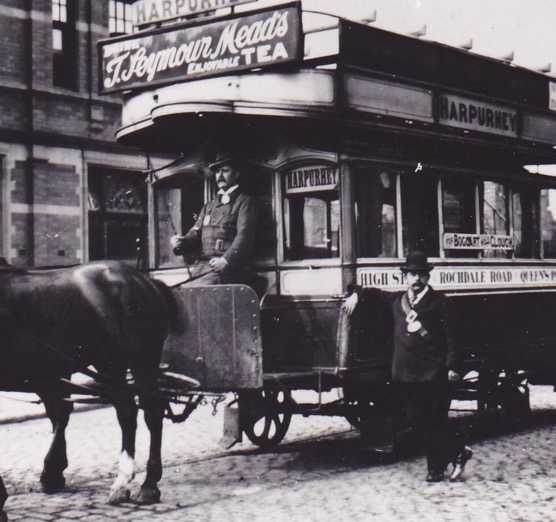
A photo taken outside the Farmyard Hotel at Barnes Green, the terminus of the Harpurhey route, of Horsecar HY-30 (a Harpurhey car) — photo undated, but from the style of the clothing, possibly taken between mid 1880s to mid 1890s. Once again, both the driver and conductor are wearing round licences. With thanks to Ted Gray. 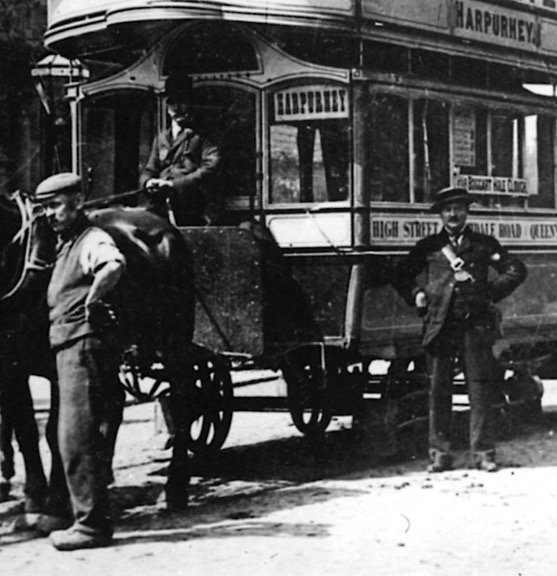
Another photograph taken at the Farmyard Hotel this time of what may possibly be Horsecar HY-14 — photo undated, but from the style of clothing, probably taken in the late 1890s or early 1900s. Both the driver and conductor are wearing licences, whilst the latter sports a straw boater, indicating that it was summertime. Photo courtesy of the Tramways and Light Railway Society, with thanks to David Voice. 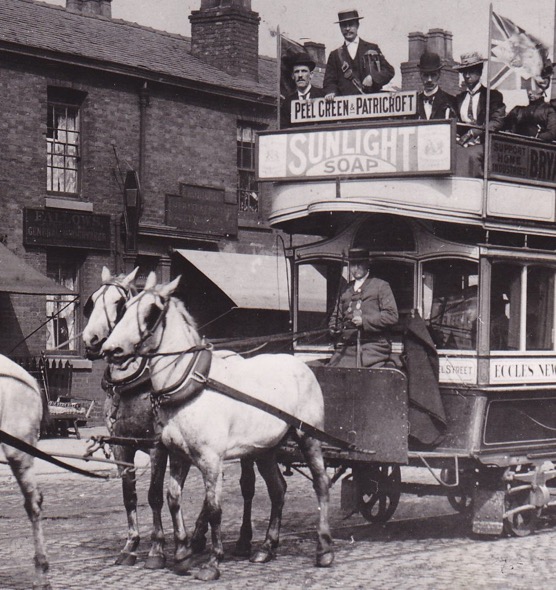
A summertime photo of Weaste-based horsecar W-35 in Eccles New Rd, Salford, on a Peel Green service in May 1894. The flags are to celebrate Queen Victoria's opening of the Manchester Ship Canal. With thanks to Ted Gray. 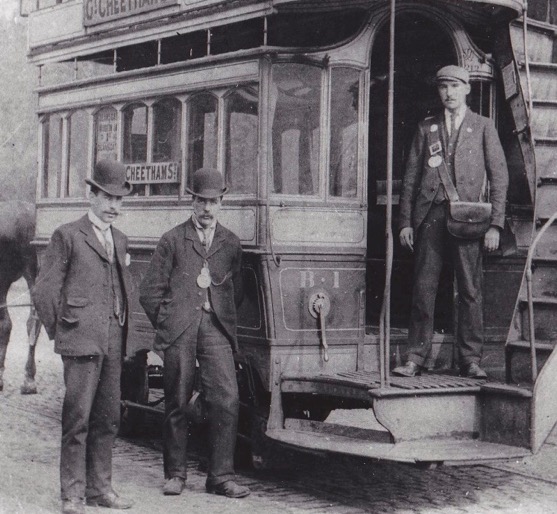
Horsecar B-1 (a Broughton car) and crew in Great Cheetham Street — photo undated, but probably mid-to-late 1890s. The conductor is wearing a flat cap rather than the usual bowler hat. With thanks to Ted Gray. 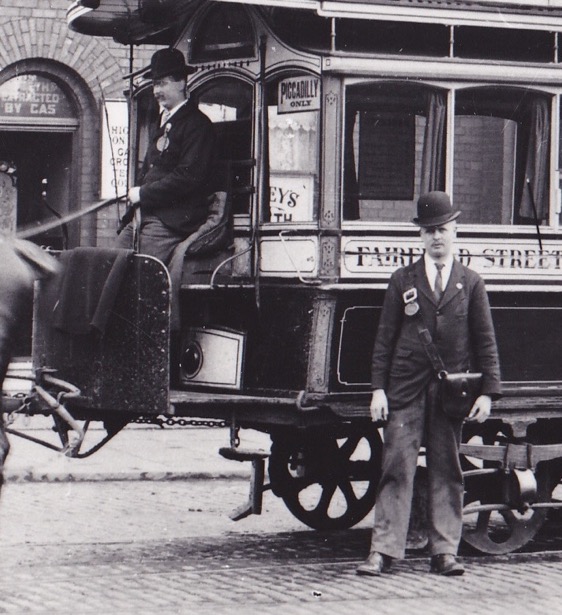
The crew of Horsecar O-4 pose with their charge — photo undated, but probably taken around the turn of the century. Note the detachable lamp behind the driver's legs, which was normally mounted on the front offside bulkhead when in use. With thanks to Ted Gray. 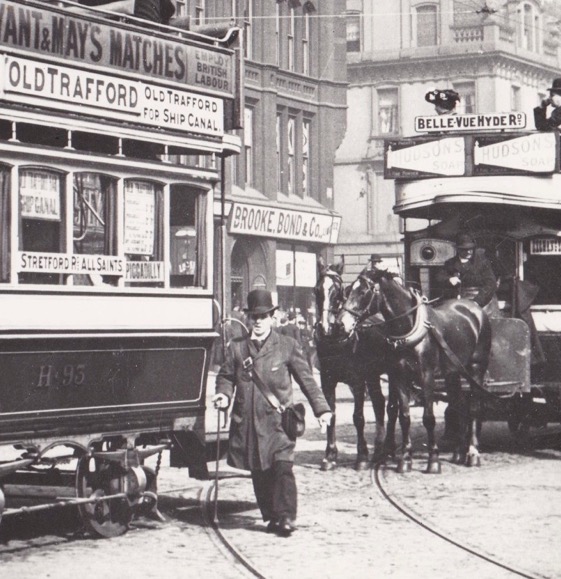
The conductor of Horsecar H-93 strides purposefully towards the front of his car, points iron in hand, in Piccadilly on 8th May 1902; the horsecar in the background is L-23. Photographer H Baddeley. With thanks to Ted Gray. 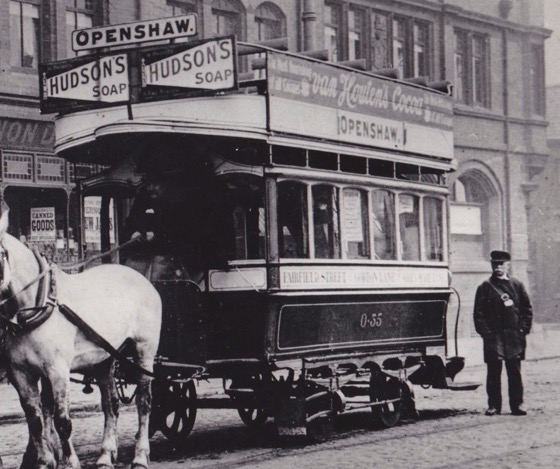
Horsecar 0-35 on the Openshaw route on the last day of its operation, 21st March 1903. The driver is believe to be Henry Wheatley (thanks to his granddaughter Adele Langstaff for this information). The conductor appears to be wearing a soft-topped cap. With thanks to Ted Gray. 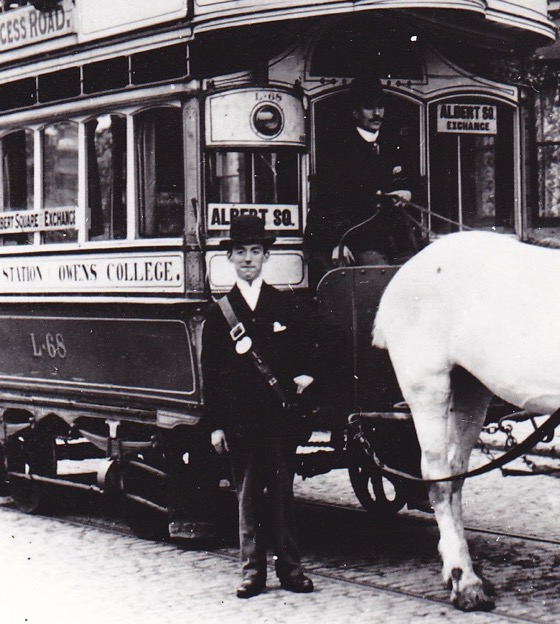
Conductor and driver pose with Horsecar L-68 (a Longsight car) on a Princess Rd to Exchange service, taken in Oxford Rd on 30th November 1903; this was allegedly the last horsecar operated in Manchester. Both men seem especially smartly turned out in jackets, with white handkerchiefs and shirts, and tall bowler hats. With thanks to Ted Gray. 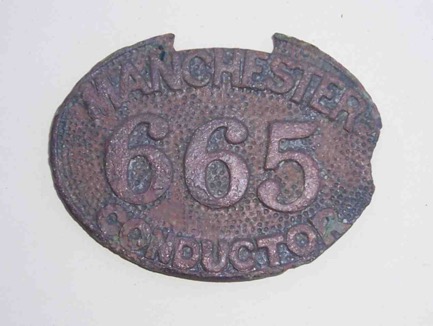
Licence — possibly of the pattern issued to MC&TCo horsecar staff.